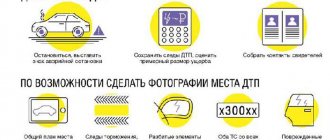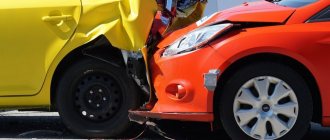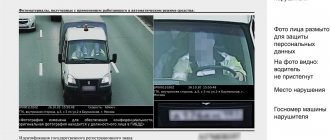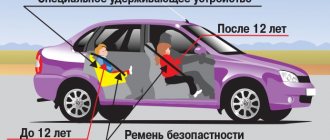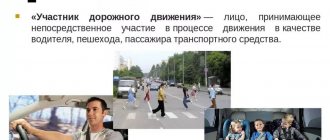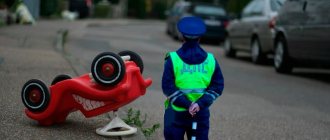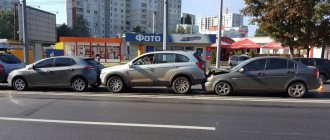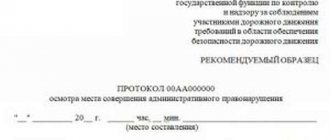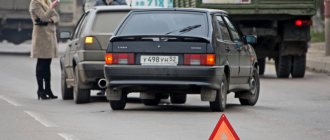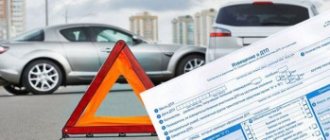A road accident that results in the death or injury of people, damage to a vehicle, or other damage is commonly called an accident. At the same time, determining who is at fault for an accident depends on many factors. As practice shows, the driver against whom a violation report is drawn up is usually found guilty. True, such a decision does not always turn out to be correct - after all, even violation of traffic rules does not always indicate the driver’s fault in the accident. Who should identify the culprit, what is the procedure for this procedure, and does compulsory motor liability insurance apply in cases where the culprits are not identified?
The procedure for identifying the culprit of an accident
In order to investigate an accident, law enforcement agencies take the following actions:
- The case materials on the incident are sent to the traffic police department, where a special administrative practice group examines in detail all the factors and causes of the accident, determines violations, and issues a decision to impose a fine in accordance with the Code of Administrative Offenses of the Russian Federation (CAO). All parties to the accident can take part in the analysis procedure. This should not be neglected. Attendance at this procedure, albeit unpleasant, but necessary, gives the participant in the incident the opportunity to prove his case and avoid charges. If a person is injured or killed as a result of an accident, the case is sent to court to initiate criminal proceedings;
- If the investigation showed the absence of violations of traffic rules and the presence of factors listed in the Code of Administrative Offenses of the Russian Federation Article 24.5. Circumstances excluding proceedings in a case of an administrative offense - the case is terminated, the participants are not held accountable, an accident certificate is issued, which indicates that there are no perpetrators;
- If a participant in an accident does not consider himself guilty and does not agree with the decision made by the “debriefing group,” he can go to court. To do this, documents are collected confirming his innocence, the amount of damage received, a statement of claim is written, to which a resolution of the traffic police is attached. The court will request the case from the traffic police and schedule a trial. To make a final decision, witnesses to the accident will be interviewed, photos, video recorders and surveillance cameras will be examined. A conclusion of a trace examination may be required, or, in the case of bodily injuries, a forensic medical examination. As a rule, these services are paid and are expensive, but worth it. Very often, based on the available data, the court cancels the traffic police decision and issues a positive verdict in favor of the plaintiff. In this case, all expenses, including those associated with conducting the necessary examinations, will be reimbursed by the defendant. In addition, the court decision will allow the guilty party to contact the insurance company and receive due compensation for material damage. If the guilt of both parties is proven in court, then the insurance compensation will be partial (usually 50%).
Who has the right to determine the culprit?
In case of an accident, it is important to establish who is the victim and who is the culprit of the incident. Naturally, traffic inspectors who arrive at the scene of an incident are required to record violations, collect primary information and evidence, and also draw up a protocol on the offense committed. Next, the collected materials are sent to the court; only the justice authorities have the right, based on the available data, to make a decision on the guilt or innocence of the citizen.
Dear reader! Didn't receive an answer to your question? Our expert lawyers work for you. It's absolutely free!
- Moscow ext 152
- St. Petersburg ext 152
- All regions ext 132 (Toll free)
This process takes place in several stages:
- a group of authorized traffic inspectors is sent to the scene of the accident, who, based on the available data, must determine the perpetrators (for example, examine tire tread marks);
- the fact of an accident is recorded in the protocol, each participant in the incident is given a certificate of participation in the accident, it indicates which driver violated the traffic rules;
- the judicial authority makes a decision on an administrative offense;
- if, during the study of the available evidence, the guilt of all drivers is established, then the punishment is assigned to each of them depending on the degree of guilt;
- if it is not possible to determine who is to blame for the incident, the paperwork is terminated, the drivers are not held accountable (in this case, a note is made in the accident certificate that there are no violators).
A situation may arise when the driver does not agree with the court decision, then he has the right to appeal it by filing an appeal. The statement briefly indicates the details and circumstances of the case. It is necessary to provide as much evidence as possible of your innocence.
The judge examines the received documents and other materials on the case presented by the driver independently. If the submitted documents, photographs, and videos are not enough, the justice authorities may request archival data from the traffic police. To do this, you must make an official request.
Based on the results of a vehicle technical or trace analysis, as well as other case materials, the court draws conclusions, although they may differ from the opinions of traffic inspectors. Only with the totality of available evidence can we say whether the driver is guilty or not.
After a court decision is made, the car owner should contact the insurer to compensate for the damage caused by the accident. In this case, the amount of compensation usually does not exceed the established limit within the framework of compulsory motor liability insurance. The application must be accompanied by a court order.
First actions after an accident
As a rule, after an accident, both participants are in a special psycho-emotional state and cannot always think adequately. Therefore, if you have any doubts about your own guilt in what happened, do not sign the documents. Then it will be difficult to prove your disagreement with what is written in them.
Remember: under no circumstances should you leave the scene of an accident, even if you are sure that you did not violate anything.
Your innocence will be in great doubt, and it will not be easy to prove it. Responsibility for leaving the scene of an accident is provided for in Art. 12.27 Code of Administrative Offenses of the Russian Federation. As follows from paragraph 2 of this article, leaving the scene of an accident is punishable by deprivation of rights from one to one and a half years or administrative arrest for up to 15 days. The law does not provide for a fine for leaving the scene of an accident.
If the participants in the accident cannot determine for themselves which of them is to blame and come to an agreement on this issue, the traffic police crew is called (the preparation of a European protocol becomes impossible).
If you see that, for a number of reasons, it is difficult to recreate an objective picture of what happened, immediately after the accident, conduct a trace examination.
Yes, this service is paid, but it will determine the true culprit of the accident and in the future, based on its conclusion, will allow you to protect yourself from false accusations in court, effectively rejecting all unlawful claims from other participants in the incident.
If you feel insecure, the situation is not in your favor, the presence of a traffic lawyer will not be amiss. He will help you navigate complex issues, avoid unreasonable financial and administrative liability, and provide psychological support.
While waiting for the traffic police to arrive, take high-quality photographs from different angles of the cars involved in the accident with clearly visible registration numbers, damage to the cars, fragments and fragments remaining on the road, the length of the braking distance, road markings, and the condition of the road surface.
Check whether your DVR recorded the moment of the accident; if not, use the recordings of external surveillance cameras of nearby establishments or nearby cars. Find 3-4 witnesses to what happened. Get their consent to appear in court if necessary. Write down your readings and contact information. Draw a diagram of the accident, keeping to scale. It should match the situation as accurately as possible.
Check that the inspector has filled out all documents correctly. It’s not clear - ask. If you don’t agree, say why exactly. The inspector ignored your remark - reflect this point in the explanatory note. If you consider yourself innocent, do not sign the resolution, demand that a protocol be drawn up. In it, in the “Driver’s explanations” field, state your own comments. Please note that if any fields or lines are left blank in the protocol, then put dashes in them.
This will protect you from entering data into the document that is not in your favor. After completing the protocol, it must be signed by you and the traffic police officer. Please note that the driver must fill out the explanation field and then sign the protocol. If he refuses to sign the protocol, then a corresponding note is made in the document. This does not make the protocol invalid. There is simply no explanation or signature from the driver.
Code of Administrative Offenses of the Russian Federation Article 28.2. Protocol on an administrative offense: a protocol on an administrative offense is signed by the official who compiled it, an individual or a legal representative of a legal entity against whom a case of an administrative offense has been initiated. If these persons refuse to sign the protocol, as well as in the case provided for in Part 4.1 of this article, a corresponding entry is made in it.
Get a copy of the protocol. Code of Administrative Offenses of the Russian Federation Article 28.26. The individual or legal representative of the legal entity against whom a case of an administrative offense has been initiated, as well as the victim, is given a copy of the protocol on the administrative offense against signature. The inspector is obliged to give you notice of the place and time of the commission on the case. Be prepared to consider the circumstances of the accident in the “analysis group” of the traffic police.
Actions of an innocent participant in an accident
If the participant in the accident does not plead guilty and does not agree with the protocol on the administrative offense, he needs to prepare a written objection. To do this, it is necessary to carefully study the road accident diagram, the available materials on the case and the protocol itself - for any violations committed during the preparation of documents.
Defend your innocence by actively participating in the analysis. To prove your case, use the testimony of witnesses, photos and videos. Request a trace examination and the inclusion of certificates from municipal services about the condition of the road surface, road illumination and weather conditions at the time of the accident.
Already at this stage, you can seek the help of a lawyer. If, however, it is not possible to challenge the guilt of violating traffic rules, an administrative fine will be issued. But even in this case, there is no need to give up. If you are sure of your innocence, go to court.
Establishing guilt in court
If the culprit does not agree with the inspector’s conclusion about his role in the accident, he has every right to file an appeal in court. Each of the parties involved tries to provide as much evidence of their innocence as possible when considering the case. For this purpose, various types of examinations are used, such as traceological or psychophysiological, in order to more accurately understand the state of the driver at the time of the accident or to examine the scene of the accident.
As a result, the following nuances will be determined:
- could it have been done differently in this situation;
- is the vehicle safe for others and the driver;
- what is the condition of the road (presence of markings, signs, whether the traffic light is working, etc.).
In turn, if the court cannot determine the degree of guilt of each of the participants in the accident, then an investigation is ordered with various additional examinations, even if they were previously carried out during an administrative investigation. Re-investigation can eliminate mistakes made initially.
The following list of documents is required in court to establish who is responsible for the accident:
- all documents from the scene of the accident;
- photo and video materials from the recorder or taken on a phone or other technical means;
- a certificate from an inspector about an accident or a resolution on an administrative offense;
- protocol and diagram of the incident from the emergency commissioner;
- if an examination was ordered for alcohol or drugs in the blood, then the document after the medical examination;
- if additional examinations were carried out, then an expert opinion.
Establishing fault at the scene of an accident
In order to prove your innocence, you need facts to confirm it. This issue needs to be given maximum attention and taken very seriously.
Necessary:
- Use DVR recording;
- Find out about the presence of external surveillance cameras from organizations located near the scene of the incident;
- Find witnesses and obtain their consent to voluntarily testify in court, if necessary. Record the testimony and contact information they provided;
- Take an active role in recreating the picture of the accident.
Usually, if an accident occurs during bad weather conditions or on a road with high traffic flow, eyewitnesses to the accident are forgotten. There is a high probability that the protocol will be filled out with procedural violations. It is difficult to dispute your guilt with such documents.
During the investigation of an accident, there are several options for the development of events:
- Both parties plead guilty;
- Both parties admit guilt, but cannot reach an agreement on determining its degree;
- Neither party considers itself guilty;
- The culprit at the scene of the accident has not been identified.
Everything is simple when there is an admission of guilt by the victim. The necessary documents are filled out, a protocol is signed and drawn up. The degree of guilt and other controversial issues are resolved in court.
Who pays insurance for an accident victim?
How to challenge guilt after an accident, if you admitted it, read here.
What to do if the insurance company demands compensation for damages for an accident, find out at the link:
It is more difficult when the culprit does not admit guilt. Then it is necessary to collect additional evidence of his involvement in the accident. Conduct traceological or automotive technical examinations. They make a request to road maintenance services to assess road and weather conditions and their impact on the creation of an emergency situation. All results of examinations and conclusions are submitted to the court for consideration.
What to do in case of such an accident?
The actions of the driver in case of an accident are prescribed in the traffic rules, but only the duties from a legislative point of view are listed there, and not only these duties must be fulfilled by the driver, but also other actions that will help you remain in the right in such a situation.
Important:
- If possible, stop immediately after a collision.
- Do not move or rearrange the vehicle, at least until you can record all the circumstances of the accident.
- Find witnesses and eyewitnesses of the accident, write down their data, ask if they have video recorders if they are drivers from other cars.
- Take photographs of cars, their relative positions relative to each other and other stationary objects.
- Be sure to take photographs of the damage on both cars and marks, fragments, etc. on road. At the same time, the damage must be photographed in great detail, and traces and fragments must be to scale relative to the cars.
- If it is not possible to photograph all this, then you can make a video recording using the same DVR (if available).
- Call the traffic police to register the incident, if necessary.
In the case when traces on the road, showing how the cars were moving before the accident, can quickly disappear (it is snowing, raining), then they must be recorded as quickly as possible.
After all of the above, when all that remains is to wait for the police to arrive at the scene, it is necessary to inspect the accident site and nearby objects. There may be video cameras somewhere that could have captured your accident.
In fact, we have listed almost everything that police officers should do after arriving at the scene of an accident. But they may arrive too late, when there are no traces to be seen, witnesses and eyewitnesses have dispersed, so it is in your interests to initially take on their responsibilities, and then provide all the information to the employees.
If witnesses or a video recording can be found only after some time, when the accident has long been documented, then the existing video recording must be attached to the case materials by written request. It is also necessary to declare in writing the presence of witnesses and their interview.
Establishing the guilt of participants in an accident in court
The initiator of determining guilt and its degree in court is the participant who believes that the decision made by the traffic police officers is unfair. During the trial, both participants in the accident may be found guilty. The court can either cancel or uphold the decision.
To recreate an objective picture of what happened, the court will carefully consider:
- actions of both motorists;
- conclusion of municipal services on the condition of the road surface;
- data on the presence, location and visibility of road markings and signs;
- data on the technical condition of vehicles.
To determine the true culprit of the accident, the court:
- will carefully study the materials provided to him;
- will identify possible violations of current legislation;
- will study expert opinions;
- If he deems it necessary, he will order additional examinations.
To draw up a statement of claim and submit the case to court, you will have to collect a package of documents:
- Certificate of traffic accident form 154;
- A protocol drawn up at the scene of an accident, with a diagram of the accident attached to it;
- Certificates of medical examination of both participants in the accident;
- Expert conclusions;
- Photos and video materials.
Mutual fault of the participants in the accident
It should be noted that there is no such thing as “mutual guilt” in the legal aspect. Usually, this term is used by traffic police officers and representatives of insurance companies to refer to a situation where both drivers are to blame for a traffic accident (each of them violated traffic rules).
Based on the results of the administrative investigation, one of the following possible decisions is made:
- One of the participants is found guilty of the accident. In this case, his insurance company pays the victim compensation for the damage caused;
- If the testimonies of the participants are contradictory and it is not possible to establish the true picture of the incident, the traffic police inspector will issue a decision and terminate the case;
- Both participants in the accident were found guilty of the accident. Each person receives a protocol and resolution. A fine is imposed for an administrative violation.
Legally, we can only talk about “mutual relationship” in the latter version. Since the legislation does not provide clear explanations on this issue, MTPL insurance companies may refuse to pay the injured party or compensate only half of the damage.
In the first case, insurers refer to the impossibility of determining the degree of guilt; in the second, they are based on the Civil Code of the Russian Federation (Article 1083), according to which the degree of guilt is recognized as equal if it cannot be established.
Very rarely, with the participation of competent and legally strong lawyers in the process, it is possible to make a payment in a different percentage ratio (80% to 20%). But it costs such moral and time that even if one of the participants in the accident is obviously at fault, few car owners bring the job they started to a victorious result. Insurance companies take advantage of this, hoping that the victim will not demand payment through the court, especially if the amount of damage is small.
Controversial situations
There are various circumstances that can affect the ability to perform maneuvers on the road. Therefore, it is not always possible to determine with the help of a diagram who is to blame for an accident when turning left. Controversial issues arise if both drivers committed actions that led to the accident. In this case, it is almost impossible to assess whose violation had a greater impact on the outcome of the situation.
This usually happens when the car starts moving at the permission signal, but does not have time to complete the maneuver. In such a situation, he tries to complete the left turn faster, which can lead to a collision with other vehicles. At first glance, it seems that the guilt of this driver has been proven, but in fact, such a case indicates that the second motorist also did not heed the warning signal.
In general, there are many controversial situations. In many of them, it is almost impossible to prove the innocence of one of the participants in the accident.
How to prove your innocence in an accident
In order to prove your innocence and reduce the consequences of an accident, you need to take a number of actions. Until the traffic police arrive, you must not leave the scene of the accident. Firstly, this can be regarded as an admission of guilt and a desire to avoid responsibility. Secondly, time is wasted, which could be used to collect the necessary evidence to confirm one’s own innocence.
The law allows leaving the scene of an accident only in the most extreme cases: if people are injured and they require emergency medical care, and it is impossible to send the victim on a passing vehicle to deliver the person to the nearest medical facility.
However, the participant in the accident must return back to the scene of the accident as soon as possible, before leaving, record the position of the car, traces and objects in the presence of witnesses, as well as take measures to preserve them and organize a detour to the accident site (clause 2.5. Traffic rules).
According to Article 12.27 of the Code of Administrative Offenses of the Russian Federation, leaving the scene of a traffic accident in which he was a participant in violation of the Traffic Rules by a driver entails deprivation of the right to drive vehicles for a period of one to one and a half years or administrative arrest for a period of up to fifteen days.
While waiting for the traffic police officers, you need to try to find less than 3 witnesses to the incident, record their testimony, contact information and obtain consent to participate in the trial. All this must then be reflected in the protocol in a special column “Explanation”.
Upon arrival, the traffic police officers give their vision of the situation, carefully study the protocol drawn up by the inspector and the diagram of the accident. If something is unclear, ask. If there are objections, put them in writing, record in the protocol the presence of photos and video materials, testimony and eyewitness data. It is important to film the video correctly.
Take photographs in such a way that you can determine from them:
- time, date and place of the incident;
- vehicles of both drivers with clearly visible registration numbers;
- braking distance size;
- car damage;
- car fragments, glass fragments;
- road surface and weather conditions.
Objection of an accident participant to the traffic police protocol
No one wants to plead guilty to an accident. However, if an accident does occur, it is necessary to adhere to a certain procedure.
Calling the traffic police is mandatory if the participants in the incident cannot come to an agreement in determining and admitting the degree of guilt or if there are victims, you must wait for the inspector to arrive.
He must inspect the scene of the road incident, draw up a protocol, draw a diagram of the accident and give an opinion on the guilt and its degree for each participant. Punishment will be assigned according to the offense committed.
If the driver who violated the traffic rules is not to blame for the incident, you need to pay special attention to the procedure for drawing up a protocol, which is subsequently signed by both parties.
The fact is that by signing a document, you agree with everything written in it. It will be almost impossible to prove otherwise later.
Therefore, consider the following nuances:
- the protocol should not contain the wording “guilty”; replace it with “driver”;
- in the “Explanation” column, indicate what exactly you disagree with;
- the traffic police officer is obliged to familiarize you with your rights, a note about this is placed in the column “I have read the protocol”;
- there must be no blank lines in the protocol; if there are any, you need to put a dash;
- it is necessary to indicate in the protocol the witnesses of the accident, otherwise, in the event of a trial, it will be difficult to attract them to testify;
- Just in case, ask yourself a copy of the protocol.
If the participant in the accident does not admit his guilt, then after receiving all the documents from the inspector, you should write a complaint to higher authorities (the head of the traffic police, the prosecutor's office) within 10 days. It is written in free form. The main thing is to indicate all the available facts, based on which you are asking to cancel or change the decision.
It is also necessary to indicate the personal data of the inspector (number of badge, certificate, full name), attach examination data, photos and videos, and eyewitness testimony. All arguments presented in the complaint must be objective, without emotion or lyricism. It can be submitted in person, through a lawyer or by registered mail with notification.
Sample complaint against a traffic police resolution.
Higher authorities are required to respond to it within 10 days from the date of receipt. If their decision turns out to be unsatisfactory, they will have to go to court.
Appeal against guilt in an accident
To prove your innocence or reduce your guilt, you need to:
- Carefully study the case materials: protocols for examining the accident site and vehicles, a diagram of the incident, conclusions of an automotive technical examination and medical examination, a certificate of an accident. It is possible that errors or procedural violations will be discovered in the preparation of documents. For example, when inspecting a car or examining drivers, there were no witnesses; their role was performed by the traffic police inspectors themselves. All this may serve as a reason to cancel the decision on an administrative violation;
- Analyze the correctness of the preparation and execution of documents. Any error found in them will become the basis for their invalidity;
- Submit a request for an independent examination. Contact a traffic lawyer for help. He can also help with choosing an organization to conduct the examination. It is very important that its representatives are competent and qualified specialists. The effectiveness of the investigation and the correctness of the conclusions drawn depend on this.
Any suspicions about the reliability and legitimacy of the accusation should become an impetus to challenge the protocol. Every nuance that arises in a case, every doubt, should not go unnoticed. Only this approach to the case will help relieve oneself of blame and avoid unreasonable demands from victims and insurance companies.
Statement of claim challenging guilt in an accident.
Is it possible to get insurance if the culprit of the accident is not identified?
In our country there are two types of liability insurance for vehicle owners:
- OSAGO is compulsory motor third party liability insurance for vehicle owners. The MTPL policy insures the driver’s liability to other road users, i.e. if the driver causes an accident, the damage to other persons will be compensated by his insurance company;
- CASCO is voluntary insurance of your car. This is a repair by the insurance company of your car in any case (even if you are the culprit of the accident, or you yourself damaged your car without an accident). CASCO is compensation for the cost of a car in the event of its theft or complete destruction. If you are at fault in an accident, the insurance company will pay compensation to the injured party (if such is established in the contract).
The weakness of compulsory motor liability insurance is the impossibility of receiving an insurance payment to the victim if the perpetrators of the accident are not identified. Since the main condition is not met - the presence of the culprit of the accident. In this case, the only way out is to go to court.
Write a statement of claim and submit a request for additional examinations:
- road. It is designed to establish the causes and conditions that contributed to the traffic accident, including the reasons caused by the poor geometry of the road section;
- traceological. It is the study of traces, as well as objects that left a trace or bearing traces, and other materials related to the event;
- auto merchandising. It determines the cost of restoration of the vehicle and its residual value.
The owner who insured the car under CASCO can repair the car free of charge and receive payment regardless of whether the culprit of the accident is identified or not. It is only important that this insured event is specified in the contract.
The driver does not admit guilt
In the case where the person responsible for the accident does not want to take responsibility for the accident, most likely the case will be heard in court. In order for a decision to be made in your favor, you need to take a number of actions immediately after the incident. First, call the traffic police to draw up a report. In this document, inspectors will detail the circumstances of the incident, which will be used in court to identify the culprit of the accident. While the traffic police are driving, do your own little investigation, namely:
- Find eyewitnesses - usually when a traffic accident occurs, a lot of onlookers gather around it. Ask and write down their details (last name, first name, patronymic, address, telephone). In the future, they will be able to testify in your favor directly at the court hearing or record it on paper;
- Check to see if there are CCTV cameras nearby that may have captured the incident. They can be located not only on roads, but also on buildings;
- interview other drivers - both those involved in the incident and those passing near the accident site. Maybe they have a dash cam in their car;
- Do not try to convince the culprit of the accident yourself. If the driver does not want to take responsibility for the traffic accident, then threats against him can only harm you later, including administrative or criminal punishment. But you still won’t be able to get compensation from the person responsible for the accident.
Upon arrival, traffic police officers draw up a diagram of the accident, a protocol from the scene of the incident, and a resolution on an administrative offense. To ensure that the culprit has less chance of avoiding responsibility, you should be very careful when signing these documents. If you disagree with something, it is better to indicate it.
Your next step is to file a claim in court, which will officially determine the culprit of the incident. If the amount of damage is less than 50 thousand rubles, then the statement of claim is filed in the magistrate’s court, if more, then in the district court. Moreover, it is better to involve as defendants not only the culprit of the accident, but also his insurance company.
Attach all the necessary documents about the accident to the statement of claim: a protocol on an administrative offense, a certificate from the traffic police, witness statements, data from video cameras, etc. To find out who is at fault for a traffic accident, the court may order an examination (or even several):
- traceological, which studies the traces left from road accidents on the road and vehicles;
- road information, which allows you to find out the condition of the road and road signs at the time of the accident;
- auto sales, with the help of which the degree of damage to the car is assessed and the cost of repairs is determined.
If you are not sure that you are right and want to know for sure who is at fault for the accident, then it is better to do an examination before going to court. Forensic research costs significantly more, and if you lose a civil case, these costs will fall on you. In order for the examination to be used in the future as evidence in court, be sure to invite the person responsible for the incident to conduct it.
After the court considers all the facts, it will make a decision on the guilt of one or another participant in the accident. If Themis is on your side, and another participant is recognized as the culprit, then you can contact the insurer with the final document to receive compensation for damage. If it is proven that there are no perpetrators of the accident, the insurer has the right not to compensate for the damage caused to the car under compulsory motor liability insurance. If it is established that both drivers are equally responsible for the accident, the liability will also be equal.
Legal proceedings can take a very long time, even years, so in most cases the best solution is to try to reach an amicable agreement with the person responsible for the accident. You may be able to convince him that the judge will not have any problems finding out who is at fault for the accident, since it is too obvious and beyond doubt. Also remember that all judicial and pre-trial costs, including examination and lawyer’s services, are borne by the party that loses the trial.
